Scroll to:
Study on the Relevance of Robotics Technology
https://doi.org/10.23947/2687-1653-2022-22-4-353-364
Abstract
Introduction. Robotic technologies serve as an important indicator of the technological and economic state of the country, they also affect the lives of individuals. Their development is a promising and urgent task affecting many aspects of the life of modern society. Currently, robotics is going through another stage of development, which has its own characteristics, new directions.
The work aims at analyzing the situation and ways of development of this industry in the world and in our country, as well as the attitude of people to the use of robotic systems and their willingness to improve them.
The topic under consideration is understudied.
Materials and Methods. In the presented work, the historical aspects of the formation of unique robotic technologies are defined, the ratio of the number of manufacturers and consumers of robotic products in the world is specified, the areas of the robotic technology application are named. The central place in the research is given to the results of an online survey conducted by the authors. Its statistical analysis made it possible to study, using specific data, the factors that influence the spread of robotic systems and robotic technologies and contribute to them.
Results. The survey results, on the one hand, showed a high assessment of the prospects of robotic systems given by the respondents, and confirmed that young people have an interest in robot-making technologies. On the other hand, they allowed us to note the high level of knowledge in the field of robotic technologies among engineering students and the presence of more than elementary knowledge of these technologies among representatives of other special fields. In the opinion of the authors, there are all prerequisites for the further successful development of these technologies.
Discussion and Conclusions. The analysis of the use of robotics in the world and in our country, as well as the results of the survey conducted by the authors, enable to conclude that these technologies are developing and will continue to develop actively, and the interest of current students in this, confirmed by the answers to the questionnaire, will contribute to the wider introduction of robots into the lives of future generations.
Keywords
For citations:
Yadrovskaya М.V., Gurin I.V. Study on the Relevance of Robotics Technology. Advanced Engineering Research (Rostov-on-Don). 2022;22(4):353-364. https://doi.org/10.23947/2687-1653-2022-22-4-353-364
Introduction. Robots are automatic devices capable of performing monotonous and complex work. They appeared in a person's life, changing over time. Over the past decade, they have transformed into mechanisms capable of effectively interacting with people, understanding their gestures and emotions. This was made possible thanks to the development of robotics. The rapid development of intelligent control and information processing technologies against the background of scientific discoveries in the field of energy, mechanical engineering, microprocessor technology and telecommunication systems determines a new stage in the production and application of robotic systems (RS) [1–3].
Robotics is an industry that widely applies modern information technologies in engineering applications, contributing to the involvement of technical means to obtain and use information to create control systems for complex objects. According to experts, robotic systems that are used in machine, automobile and shipbuilding, aviation, astronautics, medicine, textile industry, etc., contribute to an increase in the level of automation of production, which causes a reduction of 15 to 90 % of costs, depending on the area of application1.
The history of the phenomenon of robotic systems for lay persons is connected with the thoughts of science fiction writers, for experts — with the development of the first industrial robot manipulators. In fact, the concept of automated mechanisms that can independently perform the required operations appeared earlier and has gone a long way of development. In fact, the concept of automated mechanisms that can independently perform the required operations appeared earlier and has gone a long way of development. The history of the creation of robots is connected with the development of mechanics. In many countries, even B.C., the first automatic devices were designed. The principles of their creation and functioning were formulated in Ancient Greece, which can be considered the birthplace of robotics. At the final stage of the era of the Ancient World, many types of gears and engines were discovered, the basic laws of classical mechanics were formulated. With the beginning of the Renaissance, automatic mechanisms were worked out, spring and pendulum winding mechanisms were developed, which allowed skilled craftsmen to create incredible devices that were able to automatically perform certain actions. At first, these devices were entertaining and aesthetic. The technology of creating such devices has become widespread in Europe and throughout the world, it has developed and expanded the scope of application. Later on, the development of electricity technology became crucial. Electric current has become a power source, a means of receiving, transmitting and processing information. In consequence of the accumulated achievements in the 1920s and 1930s, mechanisms were developed that met the requirements of robotic systems and demonstrated scientific findings. After the end of the Second World War, the use of robotics in industry started, the functionality and control systems of robots introduced into industrial production were continuously improved [1][4].
Traditionally, industrial and service robotics is distinguished. Today, robotics is experiencing a new round of development. Mobile industrial robotics (IR), collaborative robotics (robotique collaborative), appeared, which allowed humans and robots to solve complex tasks together [5]. Two areas are developing most actively. The first is connected with remote control of robotic systems, which can be carried out by a person or a computer. The second involves the use of mechanical manipulator systems such as “arm” or “leg” for operating objects [1].
Currently, the development of robotics is based on the cooperation of independent experts, scientific organizations and companies [1]. The state plays a leading role in the development of innovative robotic technologies: implementation of national development strategies, grant financing, placement of defense orders2. The largest number of innovative robotics companies are located in Canada, Denmark, Finland, Italy, Israel, the Netherlands, Norway, Russia, Spain, Great Britain, Sweden and Switzerland [1].
Let us analyze the current state of production and consumption of robotic systems. The key manufacturers of IR are Northern and Western Europe, the USA, Southeast Asia. The following top manufacturers of robotic devices are: Japanese FANUC, Yaskawa, Kawasaki, Nachi, Denso, Mitsubishi, Epson, Omron, Swedish-Swiss ABB. New companies are also emerging. Specifically, the robotics company Universal Robotics announced itself in 2005 as a small university startup to create a compact robot2.
In 2018, 74 % of the global IR market was occupied by China, Japan, South Korea, the USA and Germany. Japan is in the first place in the world in the production and export of industrial robots: in 2018, it accounted for 52 % of the world trade in industrial robots. In 2018, the production of robotics in the USA amounted to 40.3 ths. IR, which is 22 % more than it was in 2017. Germany is the fifth country in the world and the first in Europe in terms of the IR market. It is followed by Italy and France [6].
The Asian region is considered the largest producer of IR. It should be noted that in the Republic of Korea, since February 2018, the third program “Development Strategy for the Production of Smart Robots” has been implemented. Its tasks are to popularize collaborative and service robots, increase the innovative potential of robotics, expand the robotics market, increase government support measures, and strengthen public awareness in the field of robotics3. In 2018, the production of IR in China and South Korea decreased, while in Japan it increased. Overall, the growth in the Asian region was 1 %.
The second important producer is the European region. It demonstrates a constant increase in the growth rate of IR (from 2017 to 2018, the increase was 14 %).
In 2012, the European Commission initiated the Robolaw project, aimed at solving the problems of terminology, legal and ethical standards related to robots [5]. The results of this work formed the basis of the resolution of the European Parliament of 16.02.2017 No. 2015/2103 (INL) “Norms of Civil Law on Robotics”, as well as the initiative to create the European Agency for Robotics and Artificial Intelligence and the introduction of the status of “digital persona” for robots4.
It should be noted that in Russia, legal conditions for the development of robots within the framework of “regulatory sandboxes” have also been created. Robotics is included in the list of technologies used in the framework of experimental legal regimes in the field of digital innovation due to the decree of the Government of the Russian Federation No. 1750 dated 28.10.20205.
In recent years, a record production growth of IR has been observed in North and South America (Fig. 1) [6].
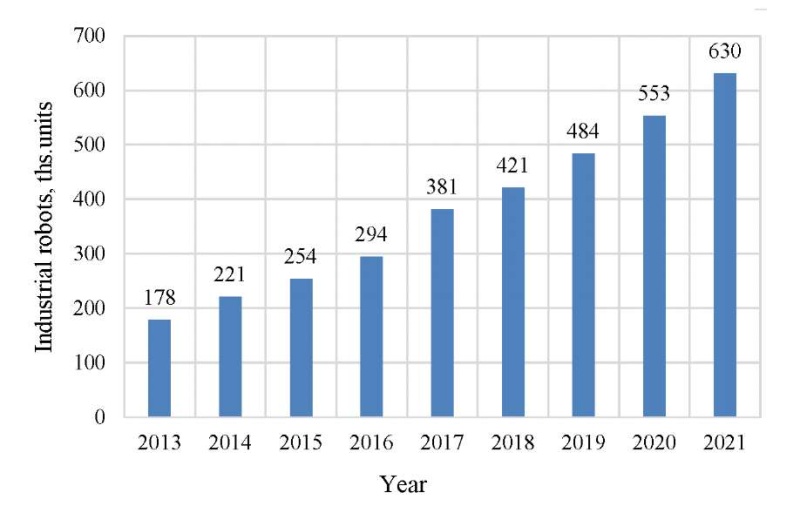
Fig. 1. Growth dynamics of the global market of industrial robots, ths. units. (the authors' figure)
China is the largest consumer of industrial robots with a share of 36 % of the total number of manufactured IR (154 ths.) with a total value of 5.4 billion dollars, which is more than the number of robots operating in Europe and America. In South Korea, the number of IR put into operation has increased by 12 % annually since 2013.
The chief user of IR in the world with a share of 30 % of the total supply is the automotive industry. The major consumer countries of such robots are China, Japan, Germany, the USA, South Korea [1].
Unfortunately, Russia is not among the top-ranking countries in terms of the use of industrial robots. The introduction of robotics is carried out at a low pace, therefore, in recent years there has not been a high growth in demand for industrial robots observed in the period from 2005 to 2010. Although interest in technologies using industrial robots is growing in our country every year, and the number of integrator companies that are technological conductors between manufacturers and end customers is also increasing [7]. The Government of the Russian Federation, within the framework of the “Strategy for the development of the information technology industry in the Russian Federation for 2014–2020 and for the future until 2025”, has included the development of robotics in the list of priority areas of technological development. According to experts, the key task of the state should be support of the R&D associated with the development of robotics, formation of an order, and stimulation of demand for products being created for various industries, including industrial production, the military industry, communications, and energy [8].
Currently, the electronics industry accounts for about a third (32 %) of robot deliveries in the world [1]. The main consumer countries of IR in the electrical/electronic industry are China, South Korea, Japan [6]. Plastics production and chemical industry use 5 % of IR supplies; food and beverage production — 3 %.
An important indicator of the industrial robotization is the number of IR per 10 thousand employees. In the manufacturing industry, this indicator is as follows: in Europe — 114 units, in the North and South America — 99; in Asia and Australia — 91. From 2013 to 2018, the average annual growth rate of the number of robots used in Asia was 16 %, in America — 9 %, in Europe — 6 %. According to this indicator, Singapore has been in first place over many years (831 IR per 10 thousand employees in 2018), South Korea (774 IR) is in second place, and Germany (338 IR) is in third place [6]. The average robotization density in Russia is twenty times lower than in the world. Unlike the West, in our country, it did not take place non-stop due to a number of socioeconomic shocks6.
Collaborative robots (cobots) are included with the IR used to perform tasks together with employees. They can complement and improve human activity without creating threats to it. They are characterized by security, relatively low price, short payback period, flexibility, multitasking. They are easily reconfigured to perform various scenarios, and they can be created by transformation from industrial robots7. These robots are most widely used in medicine, pharmaceuticals, and the automotive industry. Much attention is paid to cobots by the mass media. The market for these robots is small. In 2018, about fourteen thousand units were sold, which is 3.24 % of 422 ths. IR supplied by the customer [6].
Currently, two groups of service robots can be distinguished: professional (to benefit from the provision of services) (PSR) and personal (for use in everyday life) [6]. The market for personal robots is increasing all the time. According to forecasts, 61.1 million units (worth $11.5 billion) can be sold in 2022 [6].
European and American companies are the largest producers of PSR. Americans are leading in the segment of logistics systems, while Europeans are leading in the field of medical robotics. European and Asian companies produce 45 % of agricultural robots [6].
In 2018, the total sales of the PSR amounted to $9.2 billion. 41 % of the PSR sold were logistics systems, 39 % were PSR for inspection and repair work [3]. In 2017, a total of 6,055 robots were sold for agriculture; 300 — for mining; 1,000 — for the nuclear industry, shipbuilding and aircraft construction. It is these industries that are traditionally strong in Russia. Experts are counting on the development of robotic systems in these industries8. In 2018, 106 thousand control and maintenance systems were sold, 5.8 thousand milking robots, 5.1 thousand medical robots, which are the most expensive of service robots. Their average price is 548 thousand dollars, including accessories and services. There is also a constantly growing demand for ancillary work for the elderly in Europe and Asia [6].
The production of powered human exoskeletons capable of maintaining the ergonomics of work and reducing the burden on the employee has increased, it amounted to 7.3 thousand pieces in 2018 [6].
The distinction between industrial and service robotics is gradually eliminating due to the development of industrial use of service robotics, i.e., there is a “convergence of industrial and service robotic technologies” [1]. In the near future, the division of robots into industrial and service robots will lose its meaning, since the same robot will be able to solve tasks both in the workshop and in the service environment9.
Significant factors in the spread of robots include the high demand for robotic products, a significant increase in investment in the robot-making, an increase in the number of patents for robotic developments, and the increasingly widespread introduction of artificial intelligence (AI) systems [1]. Experts denote the trend in the development of AI robots, bearing in mind the fact that every controlled robot has AI elements10.
The increase in demand for robots is accompanied by a decrease in their cost. The average price of one industrial robot fell from $45,500 in 2016 to $44,000 in 2017, and the share of “inexpensive” robots grew.
In future, the use of robotic systems will grow, and the development of robots will be carried out in the following areas: improvement of mechanisms, drives, algorithms; development of self-learning control systems using weak artificial intelligence; development of human-computer interfaces, speech recognition, etc. [8–10]. Experts denote the need to pay special attention to cybersecurity when creating and implementing industrial robots. At the same time, cybersecurity should be understood not only as the security of human and robot collaboration, but more broadly — security of the production complex as a whole, setting up the security policy for remote robot control, commercial and industrial secrets, intellectual property protection11.
According to experts, the manufacturing industry remains the most important robotics market for the coming decade. A special contribution to robotics will be made by the digitalization of production and the development of autonomous vehicles that promote mobility. Logistics, “smart” agriculture, and healthcare, in which surgical and medical telepresence robots will acquire advantage, will also be developed [6].
Materials and Research Methods. To study the attitude to robotic technologies, a questionnaire was posted on social networks, and an online survey was conducted. The study aimed at the application of statistical methods to processing and generalizing the data obtained. The study does not claim to be fundamental, but allows us to form an up-to-date opinion about the attitude to robotic systems in society and about the current state of robotics.
Let us characterize the group of respondents. The number of respondents was 116 people. They included undergraduate and graduate students of the technical university who initiated the survey, people familiar and close to them, university lecturers. Most of the respondents were people not related to robotics. The average age of participants was 24 years. The maximum age was 67 years, the minimum — 12 years (Fig. 2). The majority of those who answered the questions were males (70 %) (Fig. 3). 58.7 % of respondents had or were receiving higher education (Fig. 4). 73.3 % majored in engineering, information technology and technical sciences (Fig. 3).
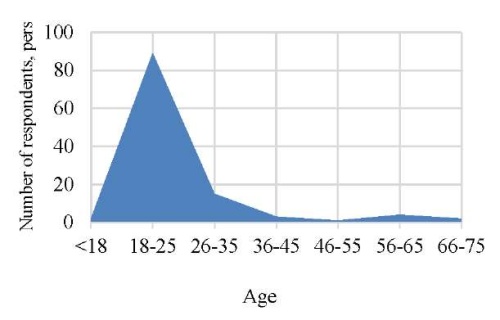
Fig. 2. Number of respondents by age (the authors' figure)
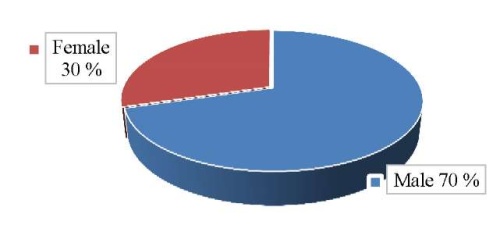
Fig. 3. Gender of respondents, % (the authors' figure)
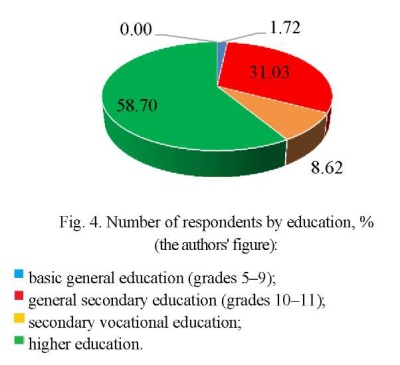
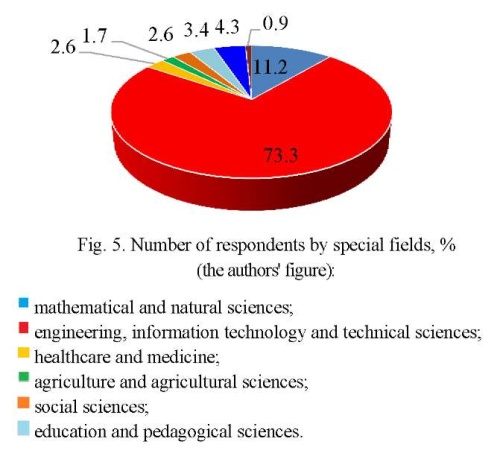
Respondents identified their hobbies as follows: programming (including microcontrollers), engineering, electronics, robotics, computer games, decorative welding, assembly of radio devices, poker-painting, writing, English, information technology, sports, reading, art, drawing, music lessons, flower-growing. As can be noted, the range of hobbies is very wide. At that, the respondents' main interests are programming, engineering, electronics, robotics, computer games and information technology, which can be proved by the specialty of the majority of respondents (Fig. 6). This fact is important for the objectivity of the results obtained.
96 % of respondents are Russian nationals. The remaining four percent of respondents do not live in Russia (Fig. 7–9).
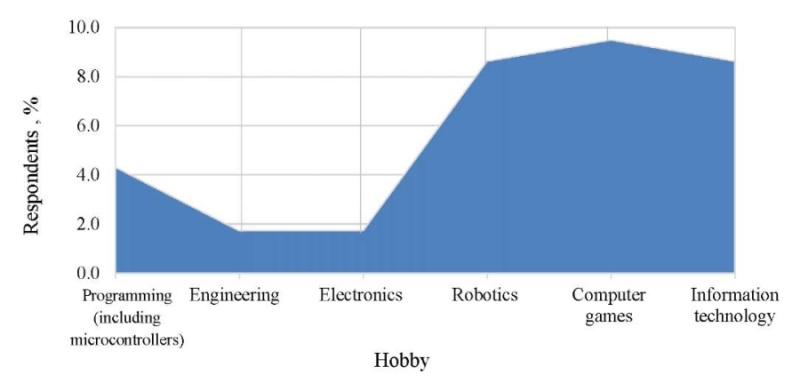
Fig. 6. Number of respondents by hobbies, % (the authors' figure)
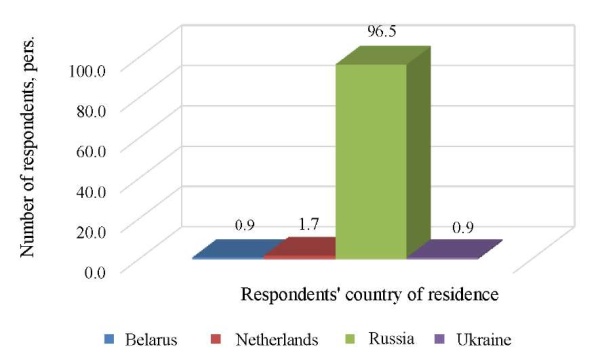
Fig. 7. Number of respondents by place of residence (country), % (the authors' figure)
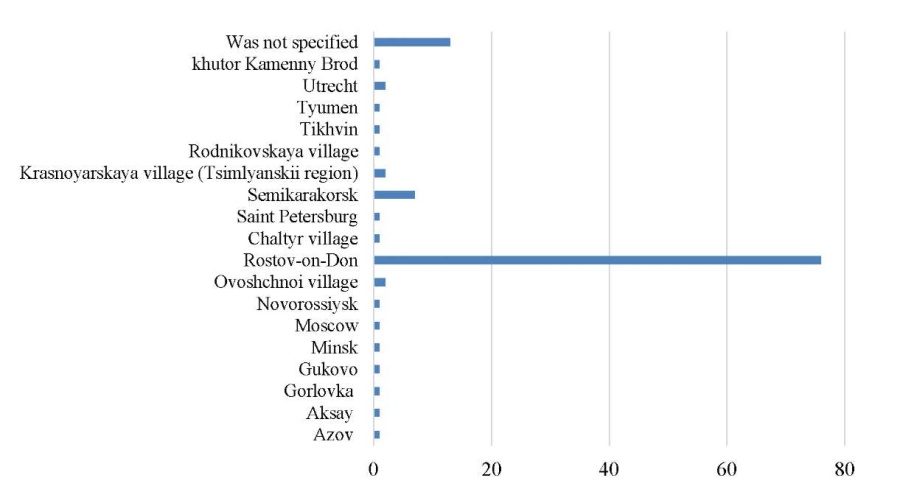
Fig. 8. Number of respondents by place of residence (settlement), pers. (the authors' figure)
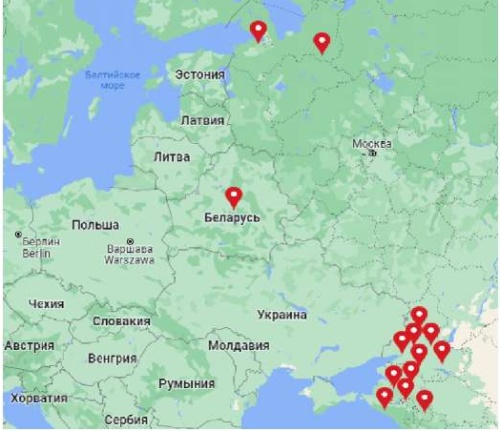
Fig. 9. Map showing respondents' placeof residence
Research Results. Let us look at the key data of the survey. 65 % of those who answered the questionnaire gave the highest rating to the prospects of robotic systems (Fig. 10). It should be noted that the hypothesis was confirmed that the opinion about the prospects of robots does not depend on the specialty of respondents. At the same time, the hypothesis is true that the opinion about the prospects of robots does not affect the definition of the field of the widest application of robotics today.
The hypothesis was also confirmed that the opinion about the most promising field of application of robots does not depend on the specialty of respondents. 48 % of respondents consider the construction sector the most promising, 33 % — industry (Fig. 11).
Residents of other countries took part in the survey. Due to the small number of foreign respondents, the question of the influence of the country of residence on determining the most promising field of application of robots could not affect the results of the survey.
The areas of the most widespread use of robots today, according to respondents, are industry (65 % of respondents think so), construction (19 %), everyday life (9 %) (Fig. 12).
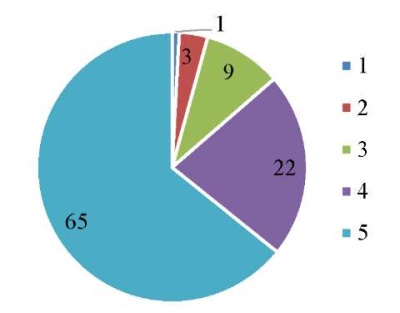
Fig. 10. Respondents’ estimates (1–5 points) about the prospects of robots, % (the authors' figure)
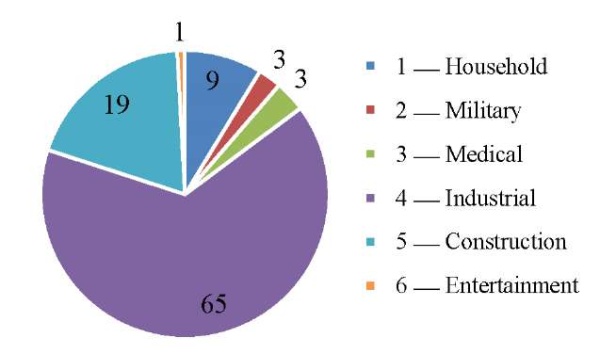
Fig. 11. The most promising areas of application of robots, according to respondents, %) (the authors' figure)
The hypothesis was confirmed that the desire to create robots and the opinion about the prospects of robots were dependent. 40 % of respondents expressed the desire to create robots, the same number considered it possible to create robots, and only 20 % of respondents did not want to do this (Fig. 13). It should be noted that the desire to create robots depended on gender, on the specialty and on the age of the respondents. At the same time, respondents were on the point of realizing the desire to create robots within their specialty.
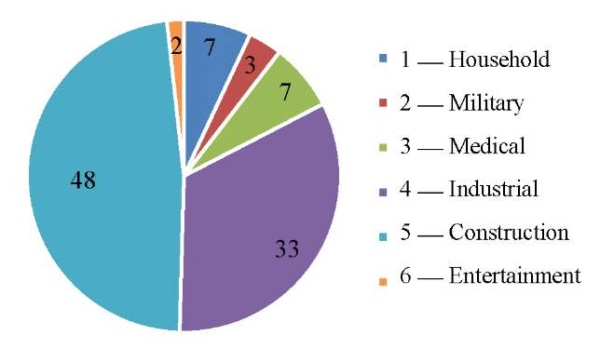
Fig. 12. Areas of the most widespread use of robots today, according to respondents, % (the authors' figure)
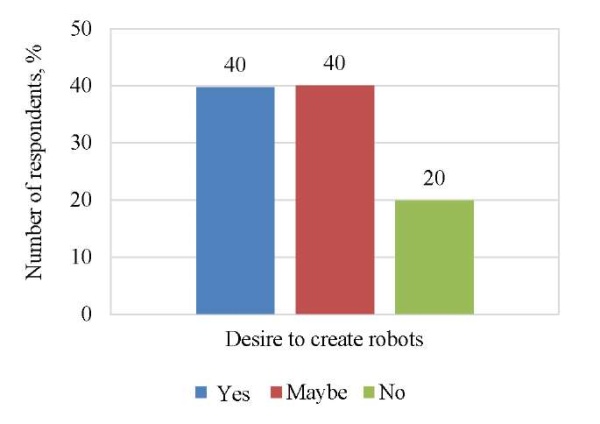
Fig. 13. Number of people willing to create robots, % (the authors' figure)
27 % of respondents gave maximum points to the desire of making robots as a hobby (Fig. 14). The same number of respondents (28 %) gave maximum points to the desire of making robots within the specialty (Fig. 15). The number of respondents who wanted to make robots as part of a hobby and as part of a specialty was in close agreement. It should be noted that the desire to make robots within the specialty depends on the specialty, on the level of knowledge in the field of robotics and on the respondents' belief in the prospects of robots, but does not depend on education.
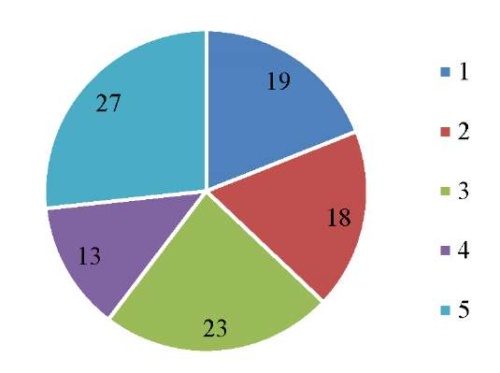
Fig. 14. Number of respondents who wanted to make robots as a hobby (1–5 points), % (the authors' figure)
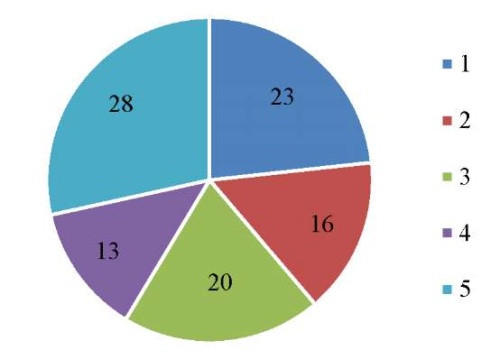
Fig. 15. Number of respondents who wanted to make robots within the specialty (1–5 points), % (the authors' figure)
29 % of respondents gave maximum points (1 point out of 5) to their level of knowledge in the field of robotics, and 5 % — the maximum (Fig. 16). 16 % of respondents gave minimum points (1 point out of 10) to knowledge of how robots are arranged and work, and 10 % — the maximum (Fig. 17).
Note that the number of respondents of all specialties decreases as their level of knowledge in the field of robotics increases (starting from the 3rd level). At the same time, the number of respondents with knowledge level 2 for all specialties turns out to be more than with level 1 (minimum level). This can be explained by the presence of certain knowledge of robotics (not only elementary) among all respondents due to their interest in this area.
No correlation was found between the level of knowledge in the field of robotics and the age of respondents, as well as their place of residence. These conclusions may become a reason for further research in the field of the quality of training of robotics experts, which is undoubtedly a challenge at the moment, taking into account global trends.
The following conclusion, which was made due to the survey, confirmed the already existing hypothesis: the level of knowledge in the field of robotics depends on gender. Indeed, more interest in this topic was shown by males. This is supported by the ratio of girls and boys majoring in the robotics at universities.
The next question concerned the influence of the specialty on the knowledge of how robots are arranged and work. Only 26 % of non-engineering respondents rated themselves for having this knowledge below level 5 (10 levels in total). Among the respondents with engineering specialties, there were respondents with a high level of knowledge of how robots are arranged and work. It is hoped that it is not just the teachers who participated in the survey. It is also important to emphasize that the inquiry revealed a very small number of respondents with engineering specialties with a low level of knowledge of robots (up to level 4). This is less than could be expected. And, conversely, there were more respondents with a high level of knowledge of robots than expected.
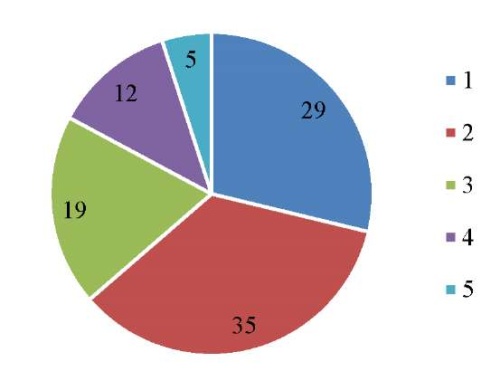
Fig. 16. Number of respondents by level of knowledge (1–5 points) in robotics, % (the authors' figure)
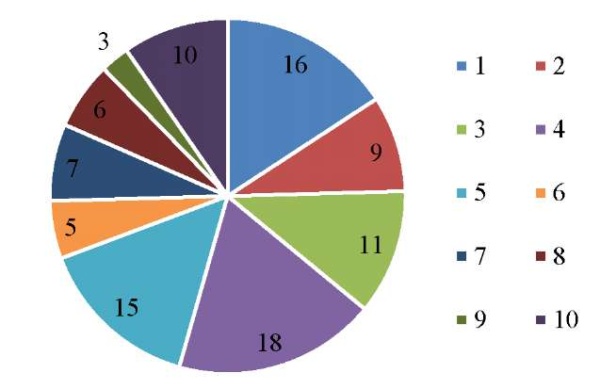
Fig. 17. Number of respondents assessing knowledge (1–5 points) of how robots are arranged and work, % (the authors' figure)
5 % of respondents believe that due to the widespread use of robotic systems, a rise of the machines is possible, 29 % doubt this possibility, and 56 % think it is impossible (Fig. 18). The opinion about the possibility of a rise of the machines depends neither on the knowledge of the device of robots, nor on the age of the respondents.
41 % of respondents are convinced that robots can displace people from jobs, 40 % consider it possible, and only 19 % do not believe in it (Fig. 19). The opinion that robots will displace a person from jobs does not depend on education, specialty, country of residence and on the level of knowledge of respondents in the field of robotics.
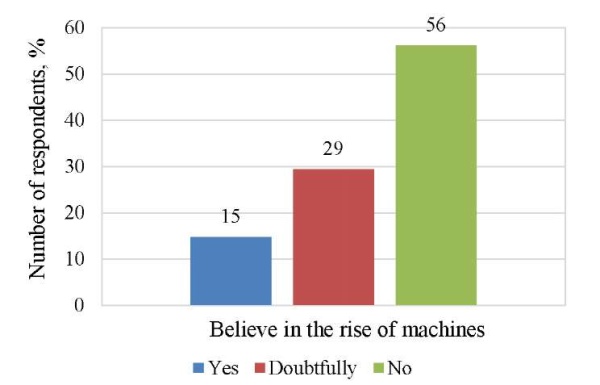
Fig. 18. Number of respondents who believe that the rise of machines is possible, % (the authors' figure)
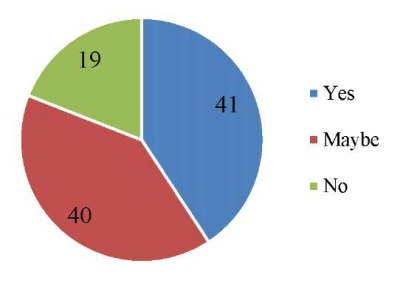
Fig. 19. Number of respondents who believe that robots can displace people from jobs, % (the authors' figure)
41 % — the maximum assessment (Fig. 20). Many people are wary of human-like robots. The gender characteristics of the respondents affected the concerns associated with man-like robots. The presence of fears associated with human-like robots does not depend on the respondent's specialty. The hypothesis that if the respondents have concerns about human-like, then they believe in the possibility of a machine rise has not been confirmed.
The majority of respondents do not have robots, except for a robot vacuum (18 % of respondents have) and some household appliances, which can partly be attributed to robotic systems (Fig. 21).
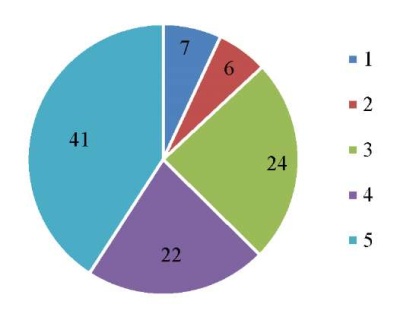
Fig. 20. Number of respondents who are afraid of human-like robots (1–5 points), % (the authors' figure)
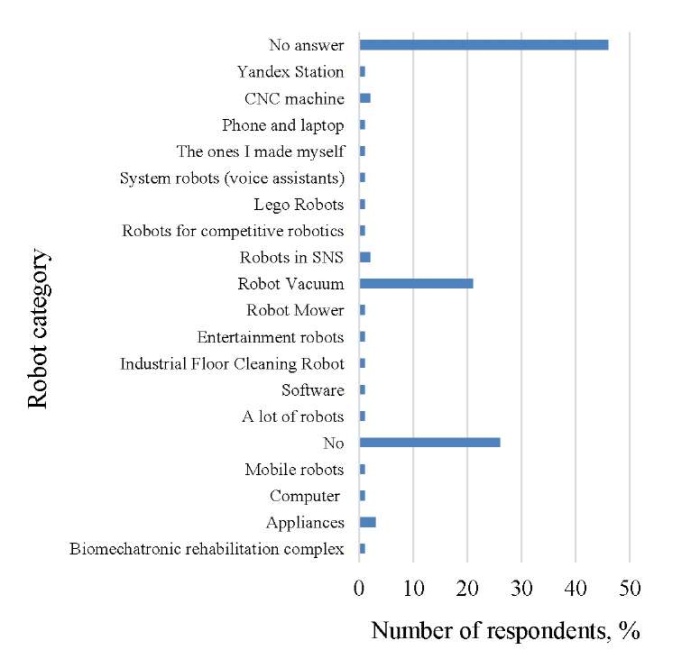
Fig. 21. Number of respondents with robots of various purposes, % (the authors' figure)
Discussion and Conclusions. The analysis of robotic technology, the study of people's opinions about the use of robotic systems allowed us to obtain the following results.
Despite the fact that the development of robotics in our country is currently being carried out at a low pace, interest in robotic technology is growing every year, separate innovative approaches to its implementation are being performed, challenging developments are emerging, and their implementation is taking place in various spheres of life.
The results of the survey have confirmed that young people show an increased interest in creating robotic systems. 80 % of respondents wish to make robots, both as a hobby and as part of their specialty, if they see the prospect of such activity. At the same time, 65 % of respondents gave a high assessment of the prospects for the development of robotic systems. Due to the fact that there were few roboticists among the respondents, the dependence of the respondents' level of knowledge on their specialty was not statistically revealed. But the hypothesis about the influence of the specialty on the knowledge of how robots are arranged and work has been confirmed. Only 26 % of respondents of non-engineering specialties gave themselves low marks for having this knowledge. Among the respondents with engineering specialties, those with a high level of knowledge of how robots are arranged and function are noted. It is hoped that it is not just the teachers who participated in the survey. It is also important to emphasize that among the respondents with engineering specialties, there were fewer people with a low level of knowledge of robots (up to the 4th level of knowledge) than could be expected. And, conversely, there were more respondents with a high level of knowledge of robots than expected.
The low level of knowledge in the robotic technology, which respondents generally noted, on the one hand, is not an obstacle to the further development of this technology due to the high degree of motivation of respondents to study and create robots, as well as due to the availability of experts. On the other hand, it is the increase in the level of knowledge that can contribute to the elimination of wariness about human-like robots, and fears associated with the idea of the possibility of robots displacing a person from his workplace.
To solve social problems related to the spread of robots in Russia, the following measures are being implemented: legal conditions are being created for the development of robots within the framework of “regulatory sandboxes”, robotics is included in the list of technologies used within the framework of experimental legal regimes in the field of digital innovation. All this, along with the efforts of universities that train students majoring in the robotic systems, allows us to hope that such technologies will be further developed, and their introduction into production and everyday life will go faster.
1. Analiticheskii obzor mirovogo rynka robototekhniki. 2019. URL: https://adindex.ru/files2/access/2019_07/273895_sberbank_robotics_review_2019_17.07.2019_m.pdf (accessed: 15.10.2021). (In Russ.)
2. Analiticheskii obzor mirovogo rynka robototekhniki. 2019. (In Russ.)
3. Kim Sang-mo. Policy Directions for S. Korea’s Robot Industry. Business Korea. Special Report on Korea's Robot Industry. 2018. URL: http://www.businesskorea.co.kr/news/articleView.html?idxno=24394 (accessed: 20.10.2021).
4. European Parliament resolution of 16 February 2017 with recommendations to the Commission on Civil Law Rules on Robotics (2015/2103(INL)). URL: https://www.europarl.europa.eu/doceo/document/TA-8-2017-0051_EN.pdf (accessed: 22.10.2021).
5. Ob utverzhdenii perechnya tekhnologii, primenyaemykh v ramkakh eksperimental'nykh pravovykh rezhimov v sfere tsifrovykh innovatsii: postanovlenie pravitel'stva Rossiiskoi Federatsii ot 28.10.2020 No. 1750. URL: http://static.government.ru/media/files/o8LH12RcKX2aDbzOOyGYp78LPATZqQu7.pdf (accessed: 23.10.2021) (In Russ.)
6. Tekhnologicheskie tendentsii razvitiya promyshlennykh robotov. Gosudarstvo. Biznes. Tekhnologii. Obzor “Rossiiskii rynok promyshlennoi robototekhniki. 2021” URL: https://www.tadviser.ru/index.php/Статья:Технологические_тенденции_развития_промышленных_роботов (accessed: 07.10.2021) (In Russ.)
7. Tekhnologicheskie tendentsii razvitiya promyshlennykh robotov. Gosudarstvo. Biznes. Tekhnologii. Tadviser. 2020. (In Russ.)
8. Analiticheskii obzor mirovogo rynka robototekhniki. 2019. (In Russ.)
9. Ibid.
10. Tekhnologicheskie tendentsii razvitiya promyshlennykh robotov. Gosudarstvo. Biznes. Tekhnologii. Tadviser. 2020. (In Russ.)
11. Ibid.
References
1. Кайснер, Э. Робототехника: прорывные технологии, инновации, интеллектуальная собственность / Э. Кайснер, Д. Раффо, С. Вунш-Винсент // Форсайт : [сайт]. — 2016. — Т. 10, № 2. — С. 7–27. — URL: https://cyberleninka.ru/article/n/robototehnika-proryvnye-tehnologii-innovatsii-intellektualnaya-sobstvennost (дата обращения: 10. 10. 2021).
2. Конвергенция биологических, информационных, нано- и когнитивных технологий: вызов философии (материалы «круглого стола») / В. А. Лекторский [и др.] // Вопросы философии. — 2012. — № 12. — С. 3–23.
3. Манько, С. В. Концепция построения мультиагентных робототехнических систем / С. В. Манько, В. М. Лохин, М. П. Романов // Российский технологический журнал. — 2015. — Т. 1, № 3 (8). — С. 156–65.
4. Колпаков, С. Г. Классификация роботов по использованию, передвижению и компонентам / С. Г. Колпаков, А. Д. Мячиков // Молодой ученый : [сайт]. — 2017. — № 3 (137). — С. 241–244. — URL: https://moluch.ru/archive/137/36438/ (дата обращения: 01. 11. 2022).
5. RoboLaw: Towards a European Framework for Robotics Regulation / Е. Palmerini, A. Bertolini, F. Battaglia [et al.] // Robotics and Autonomous Systems. — 2016. — Vol. 86. — P. 78–85. doi: 10.1016/j.robot.2016.08.026
6. Жилина, И. Ю. Мировой рынок робототехники: состояние и перспективы / И. Ю. Жилина // Социальные и гуманитарные науки: Отечественная и зарубежная литература. Серия 2: Экономика. Реферативный журнал : [сайт]. — 2020. — № 1. — С. 118–126. — URL: https://cyberleninka.ru/article/n/mirovoy-rynok-robototehniki-sostoyanie-i-perspektivy/viewer (дата обращения: 14. 10. 2021).
7. Синяков, Д. К. Темпы развития робототехники в России / Д. К. Синяков, О. Р. Ачкасов // Актуальные проблемы авиации и космонавтики : [сайт]. — 2016. — Т. 1, № 12. — С. 33–55. — URL: https://cyberleninka.ru/article/n/tempy-razvitiya-robototehniki-v-rossii (дата обращения: 24. 10. 2021).
8. Параскевов, А. В. Современная робототехника в России: реалии и перспективы (обзор) / А. В. Параскевов, А. В. Левченко // Научный журнал Кубанского государственного аграрного университета. — 2014. — № 104. — С. 1680–1701. — URL: https://cyberleninka.ru/article/n/sovremennaya-robototehnika-v-rossii-realii-i-perspektivy-obzor (дата обращения: 07. 11. 2021).
9. Комиссина И. Н. Современное состояние и перспективы развития робототехники в Китае / И. Н. Комиссина // Проблемы национальной стратегии : [сайт]. — 2020. — № 1 (58). — С. 123–145. — URL: https://riss.ru/documents/852/f26f688f72f144138a9f4eb5e28cf729.pdf (дата обращения: 11. 11. 2021).
10. Диане, С. А. К. Интеллектуальные роботы и многоагентные робототехнические системы: перспективы социальной интеграции / С. А. К. Диане // Философские проблемы информационных технологий и киберпространства : [сайт]. — 2016. — № 2 (12). — С. 74–83. — URL: https://cyberleninka.ru/article/n/intellektualnye-roboty-i-mnogoagentnye-robototehnicheskie-sistemy-perspektivy-sotsialnoy-integratsii (дата обращения: 25. 11. 2021).
About the Authors
М. V. YadrovskayaRussian Federation
Мarina V. Yadrovskaya
1, Gagarin Sq.
Rostov-on-Don
I. V. Gurin
Russian Federation
Ilya V. Gurin
1, Gagarin Sq.
Rostov-on-Don
Review
For citations:
Yadrovskaya М.V., Gurin I.V. Study on the Relevance of Robotics Technology. Advanced Engineering Research (Rostov-on-Don). 2022;22(4):353-364. https://doi.org/10.23947/2687-1653-2022-22-4-353-364













































